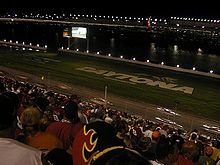Coke Zero 400
| Venue: | Daytona International Speedway |
| Main sponsor: | The Coca-Cola Company |
| First race: | 1959 |
| Distance: | 400 miles (644 km) |
| Number of laps: | 160 |
| Former names: |
Firecracker 250 ( 1959 - 1962 ) Firecracker 400 ( 1963 - 1984 ) |
The Coke Zero 400 is a 400 mile race in the NASCAR Sprint Cup at Daytona International Speedway . It traditionally takes place on the night of the first Saturday in July, usually the Independence Day weekend. It is the only Restrictor Plate race that takes place at night.
The Coke Zero 400 was also previously known as the Pepsi 400 , Firecracker 250, and Firecracker 400 .
history
In 1959, the race was initially planned as the USAC championship of today's Champ Cars . However, after a race with many accidents in April, the formula racing races were permanently removed from the track's calendar. NASCAR took advantage of this gap and replaced the failed race with its own race.
This NASCAR race was designed as the second big race in the Cup series at Daytona International Speedway, but which should not affect the legendary status of the Daytona 500 . Initially, the race was for 100 laps, i.e. 250 miles, with July 4th, American Independence Day, as the race date. These first races were known as the Firecracker 250 . After the race was extended to 160 laps and thus 400 miles in 1963, the official name was Firecracker 400 .
From the first race in 1959 to 1987, the race was always held on July 4th, regardless of the day of the week. Since the 1988 season, the race date has always been the first Saturday in July, i.e. the Saturday closest to July 4th. It was also in 1988 when Bill Elliott won the race from position 38. It was the worst starting position from which a race at Daytona has ever been won.
In the 1998 season, the race had to be postponed to October due to forest fires in Florida . Before it turned into a night race from this season onwards, the start usually took place around 10 or 11 a.m. to avoid the very high temperatures and regular thunderstorms in the afternoon.
In 1984, Ronald Reagan became the first sitting President of the United States to attend a NASCAR race. The President gave the go-ahead signal by phone from the Air Force One board . After landing, he drove to the racetrack and watched it with Bill France Jr. , President of NASCAR. During the race, Reagan was interviewed by former NASCAR driver Ned Jarrett , who began a career as a radio commentator in 1978. The Firecracker 400 of the 1984 season is also legendary, as Richard Petty achieved his 200th and last victory of his career here. After the race, Petty and President Reagan were interviewed together, and Reagan was present at the victory ceremony on Victory Lane by Petty and his family.
With the end of the 2007 race, Pepsi retired as the main sponsor of the race, which it has been since 1985. Coca-Cola signed a contract as the new main sponsor of the race, and since 2008 the race has been called the Coke Zero 400 .
winner
- 2015: Dale Earnhardt junior
- 2014: Aric Almirola
- 2013: Jimmie Johnson
- 2012: Tony Stewart
- 2011: David Ragan
- 2010: Kevin Harvick
- 2009: Tony Stewart
- 2008: Kyle Busch
- 2007: Jamie McMurray
- 2006: Tony Stewart
- 2005: Tony Stewart
- 2004: Jeff Gordon
- 2003: Greg Biffle
- 2002: Michael Waltrip
- 2001: Dale Earnhardt junior
- 2000: Jeff Burton
- 1999: Dale Jarrett
- 1998: Jeff Gordon
- 1997: John Andretti
- 1996: Sterling Marlin
- 1995: Jeff Gordon
- 1994: Jimmy Spencer
- 1993: Dale Earnhardt
- 1992: Ernie Irvan
- 1991: Bill Elliott
- 1990: Dale Earnhardt
- 1989: Davey Allison
- 1988: Bill Elliott
- 1987: Bobby Allison
- 1986: Tim Richmond
- 1985: Greg Sacks
- 1984: Richard Petty
- 1983: Buddy Baker
- 1982: Bobby Allison
- 1981: Cale Yarborough
- 1980: Bobby Allison
- 1979: Neil Bonnett
- 1978: David Pearson
- 1977: Richard Petty
- 1976: Cale Yarborough
- 1975: Richard Petty
- 1974: David Pearson
- 1973: David Pearson
- 1972: David Pearson
- 1971: Bobby Isaac
- 1970: Donnie Allison
- 1969: LeeRoy Yarbrough
- 1968: Cale Yarborough
- 1967: Cale Yarborough
- 1966: Sam McQuagg
- 1965: AJ Foyt
- 1964: AJ Foyt
- 1963: Fireball Roberts
- 1962: Fireball Roberts
- 1961: David Pearson
- 1960: Jack Smith
- 1959: Fireball Roberts

